There was a thread on the forums this week about what do you like most about Rolemaster, HARP, and MERP. One of the things that stood out was half the people liked the detail and ‘crunch’ of certain rules. Others valued the simplicity or lack of ‘crunch’ of certain rules.
It was not that there are crunchy people and non-crunchy people. There was not one dissenting voice over the simplification of spell casting in RMu.
One the other hand there were two camps on the topic of combat. For some the one weapon, one combat table was desirable, but married up with a generic critical table for all piercing or all slash wounds. HARP has the least crunchy combat with one single roll on a different table for each class of weapon but those weapons each get their own unique critical tables. Less dice rolling, less tables but more flavour. The middle ground is the RMFRP way of tables for a group of weapons, all the possible armour types but the traditional generic combat tables.
The take away regarding combat is that there are four systems in common use, they all give the same net result, the same numbers of hits taken and the same scale and severity of criticals and largely use the same language, #hits, and A-E (and beyond) criticals.
Any table-driven combat system cannot get away from that appearance of crunch, you will never be free of the book or a laptop/tablet if you use automated software for your combats.
A different sort of crunch was apparent in people’s preception of skills. I think of this as ‘mined crunch’. You can have a few broadly defined skills, or you can mine down into more specific skills and then mine further down into detailed specializations.
The simpler, broader defined skills, suggest a more traditional OSR style of play. If you want to say something diplomatic you just role play and say something diplomatic. An infinite array of skills leads down a path that leads to
Player: I want to say something to defuse the situation.
GM: OK, roll your public speaking.
There are strengths and weaknesses to both styles of play. If you feel self-conscious playing in characters and making speeches in front of the group then just rolling the dice holds a lot of attractions.
The broad skill approach requires a stronger character concept to play correctly. If there is just one Athletic Games skill and your character comes from a seafaring nation then you are going to be adept at games from rowing to climbing rigging and possibly swinging from ropes. Put that character in the far north and although you have the applicable skill it does not mean you can ski like a pro. You have to role play your character concept. There is no reason not to take skiing instruction and then be able to use the character’s core strength and trained balance to add skiing to their repertoire, but that should develop through play.
All of that can be avoided by having a great many layers of skills, and crunch, which tightly define what a character can and cannot do, and then a layer of similar skills to say what they know that could cross over. It is either replacing role-playing your character concept with a less flexible but more structured approach.
Neither is right or wrong. What I struggle with is the latter method does become very slow at character creation, a great many similar but different professions and a great spectrum of skills that all take time to pick and record. That married up with a very dangerous combat system and high lethality.
I see this kind of crunch as a more personal choice. Some people want it, some people don’t. The net effect is the same, characters are designed first and foremost by the player’s character concept and then the skills are bought to map that concept to the game rules. You can never totally escape combat tables if you play RM, HARP or MERP but the level of skill, and even profession crunch is within your power.
I think the Rolemaster community will always be polarised by this desire for more detailed simulation vs. less detailed simplicity. The four corners all suffer the same polarisation, character creation, combat, magic and spells, and monsters. The two sides cannot be reconciled because how could you possibly think it is a good idea to take away your ability to handcraft every monster in every encounter if that is what you love doing? The same is true for every aspect.
This is also why RMu has taken a decade to get this far and is still just a distant dream. There is little unity in a community that all wants different things.


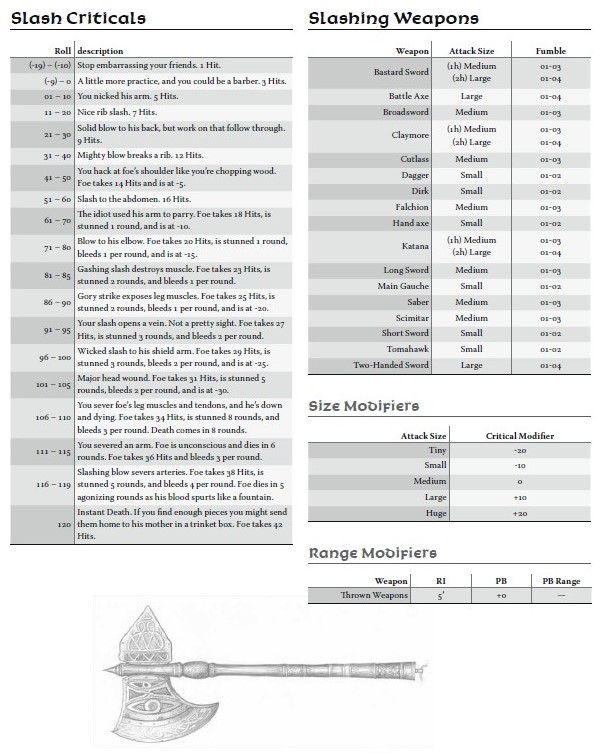
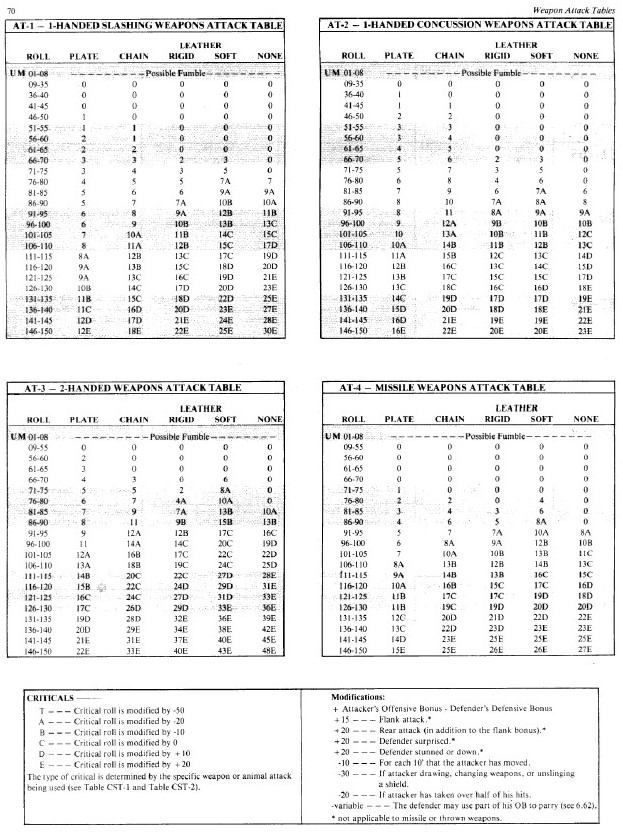
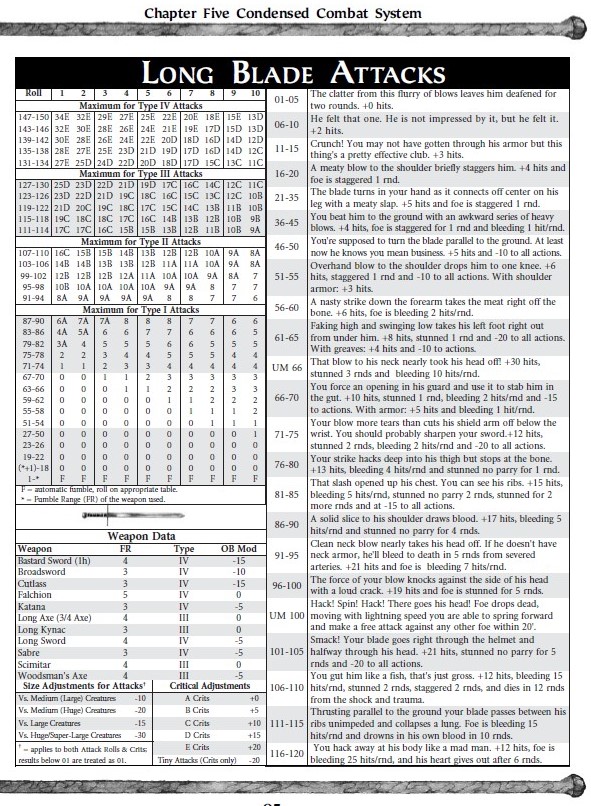
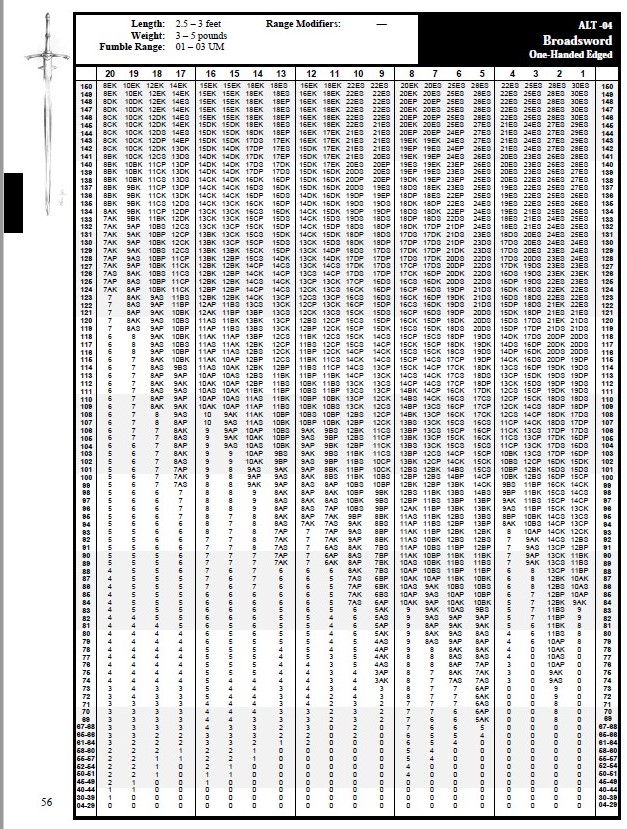
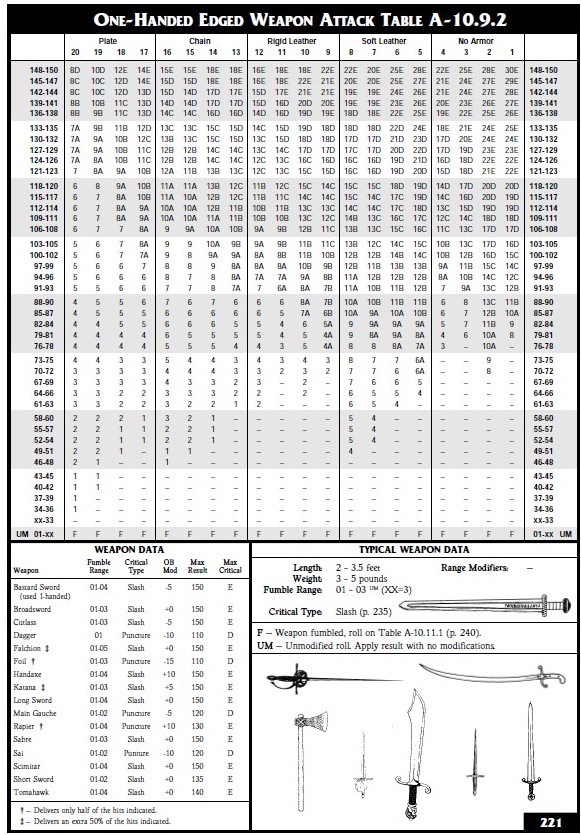
“… they all give the same net result, the same numbers of hits taken and the same scale and severity of criticals…”
Do they though? A Falchion in RM2 got a lot of Krush criticals against plate armor. How do the condensed charts of RMC, HARP, and MERP determine the critical type, or represent the difference between hitting armor and penetrating it? I’m also not sure either the hit point values or critical severities line up either. A RM2 broadsword against AT 8 maxes out at 20EK. The same weapon in MERP seems to max out at 25E (there is no 20E result at all on the MERP chart). Similarly, I don’t see any 20E result on the condensed charts for RMC CC; the result seems to be 19D? I can’t tell what it would max out at in HARP at all.
It seems to me then that the results are not the same. The variations in this instance are small, to be sure, but they can add up. At the very least they add variety, and help to distinguish weapons in a way that DnD cannot.
I think looking at the actual numbers of hits delivered and saying 20 is not the same as 25 misses the point and not what I meant by saying they achieve the same job. In MERP, for argument sake, Body Development works differently, with different professions being given a set number of ranks per level. In RMu the BD skill is used and no dice.
By saying they are the same I mean that they all use slightly different table formats to achieve the same goal.
HARP is the most different, there are no armor types at all, the different armors result in a DB bonus and the adjusted attack roll is the critical roll.
RM2/RMC is the most detailed and most cumbersome to use. Each weapon has its own chart and the critical tables together in a block later in the book. Unless you start pulling out pages or printing extra copies you have to flick back and forth. The full RMFRP Arms Law puts a full RM2 attack table, the sort you like with the related critical tables on the next page. It ups the page count but makes combats run faster by cutting out the page flipping.
The RMFRP page above is from the RMFRP single-volume book. I bought that last year, just for reference.
The RMC CC version loses more fidelity in that the criticals are condensed, this is its greatest weakness as the same critical results come up too often. You gain speed at the table. Every one of my PCs are using long blades and I can run entire combats without having to turn a page. The weapon specific criticals are really nice. In RM2/RMC/RMSS and RMFRP a C puncture critical from an arrow, a dagger and a lance all do exactly the same wounds. In the Combat Comapnion tables, there is no such thing as a puncture critical, there are arrow criticals, short blade criticals and lance criticals.
Ok, I understand what you are saying now.
The Combat Companion approach is intriguing. I don’t like condensed charts, but the idea of weapon-specific criticals is cool. I think one could apply it to the more traditional RM2-style critical charts without any problems. I had been thinking of trying to generate houseruled critical charts to break up the monotony of the same critical results — these would have the same mechanical results, but different flavor, to keep things fresh.
Yes, they are easy enough to make. I flaw, for me is that the CC tables only have 20+ possible criticals. If everyone is using a long blade, your broadswords and longswords, by the time you have five PCs and as many foes each doing a critical each round, by the third round you have criticals repeating themselves.
I made an alternative set of criticals for the most commonly used weapons in my game. I swap them in and out each session just to create more variety.
I know this is a bit of an ugly image but it gives a good indication of the variety.
Crunch in combat is the least of my concerns. You can dial it up or down as you wish. The reason our group is back at MERP is that the players didn’t want to have a skill/table for each weapon. I have kind of bypassed a bit of that by using Minion. Criticals are just interpreted on weapon choice and I get creative with the description.
However, the upshot is that we have a very vanilla skills development method. Everyone is an expert with a class of weapons. Everyone has core adventure skills. No-one really has any skills that give the character’s background. Generally, we roleplay the skills and I roll a measure of success because our characters are not us. None of us are top-level diplomats, skilled musicians, woodworkers, sailors, cavers or whatever background skills we think or character should have. As people, we have a wide range of skills and interests and so can interpret feasibility but we can’t roleplay that to match our character. I think if we were to adopt a simpler development system (the players don’t like the x/y development points) and use the broad sweep of metaskills with a focus/specialism bonus we would be a happy group. I think that is why I am following the levelless development path. In essence, we may be a group that sits in the middle of the crunch range
Both myself and my players have always liked the Combat Companion version of tables the best. If nothing else for the speed and easy of use. Some of my more crunchier players have always liked the RMC version simply because of the single digit effect ranges, versus the 3 digit range in FRP and the 4 in CC. HARP’s version I have always disliked because it was so stripped down that I felt I was back in a d20 system. {ugg}
As far as skills go it’s a touch and go situation. New players feel overwhelmed by the choices, whereas my experienced players love the detail. I GM’ed my RMu campaign using RMu’s skills, but supplemented with details from School of Hard Knocks material. I found all players liked the detail of difficulty levels & success/failure from SoHK, but the new players were especially glad they didn’t have to manage (and pay for) 10+ skills, vs the 6 or so in RMu.
I guess my take on it is for ICE to simply embrace the individuality of their players, and roll with it. As long as the detail is available (via Companions foe example), but not forced, I have no problem with it. (*)I suspect (at least from my own conversations) that heavy handed attempts to enforce a homogenized baseline (i.e. HARP?) would probably backfire.
Dave
(*) After all, how many 5e GM’s pull rules and ideas from other d20 systems? I’ve personally seen plenty of non-standard play that certainly didn’t come from the RAW 5e rules, and it certainly hasn’t hurt that product. I suspect it’s the main reason WotC has certified ‘Adventurer League’ games. =)
Pardon: The 10 vs 6 skills I was referring to was in the Social category of RMu.
RMu: Social: Influence,Charm,Duping,Intimidation,Leadership,Social Awareness,Trading
RMFRP Influence: Bribery, Diplomacy, Duping, Interrogation, Leadership, Propaganda, Public Speaking, Seduction, Trading. RMFRP Awareness: Lie Detection